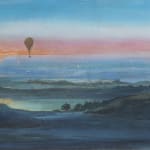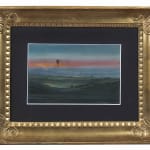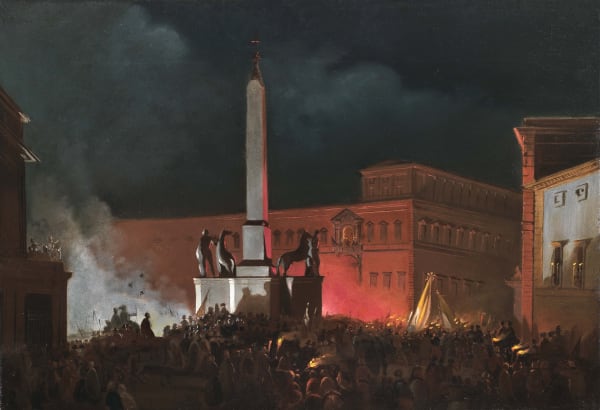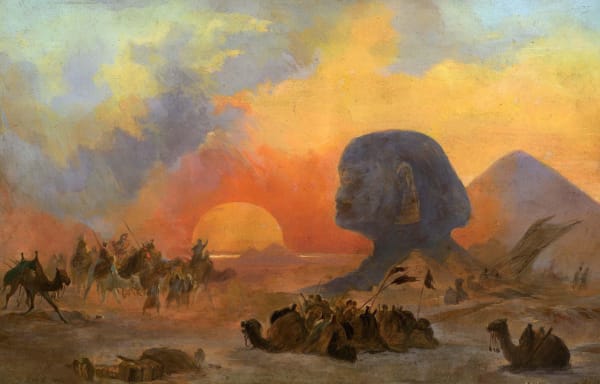-
Artworks


IPPOLITO CAFFI BELLUNO 1809-LISSA 1866
Ascending over the Roman countryside in a hot air balloon (Lake of Albano), 1847Tempera on cardboard14 x 22,5 cmSigned lower right: CaffiSOLD
Ippolito Caffi, from the Veneto region, can be considered one of the most important landscape painters of the nineteenth century with a contemporary flavour.
Defined “the last heir of Canaletto” thanks to his perspective skills, Caffi actually bettered and diverged from the Canaletto tradition, enriching it with an accentuated understanding of atmospheric data and a refined study of the effects of light, to the point of leading the genre of landscape painting towards contemporaneity. Annalisa Scarpa defines this as an “emotional light” which Caffi translated into paint and it is this that makes his paintings so poetic, fascinating, and appealing.
He often tackled unusual subjects and the work presented here is an example of this. The balloon flight was one of the most exciting experiences that Caffi ever had, an experience which catapulted him into contact with the sky and its hyperbolic immensity, an emotion which would be translated into paint. His palette, habitually rich in definitions, here turns into a delicate continuous shade of pink and orange where the sunset is muddled and lost in the softness of the horizon in which the gaze also loses itself.
This poetic painting on cardboard, never published, can be added to the three already known versions of the balloon flight which Caffi took on April 5, 1847; one kept in the collections of the Galleria Comunale d’Arte Moderna dei Musei Civici di Treviso[1], (with the same subject - with a view near the lake of Albano), one at the Galleria Internazionale d'arte Moderna of Ca’ Pesaro in Venice[2], and the third in a private collection depicting a view of the Balloon Ascending from the Campo of Siena.
It is known that the French aeronaut François Arban, who piloted the hot air balloon, wanted a picture from the artist in exchange for the panoramic tour.
"We know of the flight that it left late, around six in the afternoon, that it lasted an hour and a half, that it reached three thousand meters in height and that the thermometer reached five degrees below zero"[3].
The enthusiastic artist, in order to board the vehicle which would allow him to look at the most beautiful views of Rome from above, began an argument with another aspiring passenger. Caffi related the exciting adventure in a long letter to a friend of his, which “Il Vaglio” (an anthology of periodical literature from Venice) published in full on June 12 of the same year. “The burning solar disc still appeared on the horizon and produced a spectacle of extraordinary beauty with its scorching face, while before our eyes the earth seemed no more than a darkly opaque stain and I would say almost imperceptibly mottled with many colours and especially in the violet range.” The artist's words perfectly describe this almost childlike emotion which he was able to translate into paint with such delicate poetry.
[1] Caffi. Luci del Mediterraneo, curated by Annalisa Scarpa, Belluno, Palazzo Crepadona, October 1, 2005 – January 22, 2006; Rome, Museo di Roma – Palazzo Braschi, February 15 – May 2, 2006,cat. n. 89, pp. 184, 283
[2] Ippolito Caffi. Tra Venezia e l’Oriente 1809-1866, curated by Annalisa Scarpa, Venezia, Museo Correr, May 28 – November 20, 2016, n. 41, pp. 108, 109
[3] Annalisa Scarpa, in Caffi. Luci del Mediterraneo, p. 284
Join the mailing list
Subscribe to our newsletter to receive all the news about exhibitions, fairs and new acquisitions!





